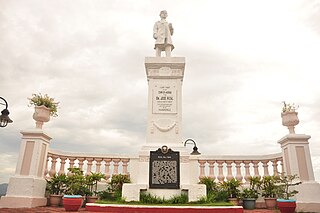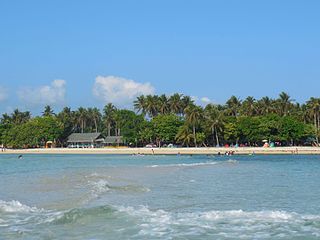
Calabarzon, sometimes referred to as Southern Tagalog and designated as Region IV‑A, is an administrative region in the Philippines. It is situated southeast of Metro Manila and is bordered by Manila Bay and the South China Sea to the west, Lamon Bay and the Bicol Region to the east, Tayabas Bay and the Sibuyan Sea to the south, and Central Luzon to the north. Comprising five provinces—Cavite, Laguna, Batangas, Rizal, and Quezon —and one highly urbanized city, Lucena, it is the most populous region in the Philippines, according to the 2020 census (PSA), with over 16.1 million inhabitants. It is also the country's second most densely populated region, after the National Capital Region. Calamba in Laguna serves as the regional center, while Antipolo in Rizal is the most populous city in the region.

Aurora, officially the Province of Aurora, is a province in the Philippines located in the eastern part of Central Luzon region, facing the Philippine Sea. Its capital is Baler and borders, clockwise from the south, the provinces of Quezon, Bulacan, Nueva Ecija, Nueva Vizcaya, Quirino, and Isabela. Maria Aurora is the only landlocked town in the province and yet, the most populous. It is the only province in Central Luzon that has no chartered cities.

Quezon City, also known as the City of Quezon and Q.C., is the most populous city in the Philippines. It is also the richest city in the Philippines. According to the 2020 census, it has a population of 2,960,048 people. It was founded on October 12, 1939, and was named after Manuel L. Quezon, the second president of the Philippines.

Central Luzon, designated as Region III, is an administrative region in the Philippines. The region comprises seven provinces: Aurora, Bataan, Bulacan, Nueva Ecija, Pampanga, Tarlac, and Zambales; and two highly urbanized cities, Angeles and Olongapo. San Jose del Monte is the most populous city in the region. The region contains the largest plain in the country and produces most of the country's rice supply, earning itself the nickname "Rice Granary of the Philippines". It is also the region to have the most number of provinces.

Baler, officially the Municipality of Baler, is a municipality and capital of the province of Aurora, Philippines. According to the 2020 census, it has a population of 43,785 people.

Infanta, officially the Municipality of Infanta, is a municipality in the province of Quezon, Philippines. According to the 2020 census, it has a population of 76,186 people.

Kalayaan, officially the Municipality of Kalayaan, is a municipality in the province of Laguna, Philippines. According to the 2020 census, it has a population of 24,755 people.
Horacio Villamayor de la Costa was a Filipino Jesuit priest, historian and academic. He was the first Filipino Provincial Superior of the Society of Jesus in the Philippines, and a recognized authority in Philippine and Asian culture and history.

Lucban, officially the Municipality of Lucban, is a municipality in the province of Quezon, Philippines. According to the 2020 census, it has a population of 53,091 people.

Mauban, officially the Municipality of Mauban, is a municipality in the province of Quezon, Philippines. According to the 2020 census, it has a population of 71,081 people.

Perez, officially the Municipality of Perez, is a municipality in the province of Quezon, Philippines. According to the 2020 census, it has a population of 12,767 people.

Quezon, officially the Province of Quezon and historically known as Tayabas, is a province in the Philippines located in the Calabarzon region on Luzon. Lucena, a highly urbanized city governed separately from the province, serves as its the provincial capital and its most populous city. The name of the province came from Manuel L. Quezon, the president of the Philippines from 1935 to 1944. The province was known as Kalilayan upon its creation in 1591, renamed as Tayabas by the 18th century, before settling on its current name in 1946. To distinguish the province from Quezon City, it is also known as Quezon Province, a variation of the province's official name.

Tayabas, officially the City of Tayabas, is a component city in the province of Quezon, Philippines. According to the 2020 census, it has a population of 112,658 people.

The Malagonlong Bridge and is a five-span 445 ft (136 m) long stone arch bridge built during the Spanish colonial period in Tayabas, Quezon, Philippines. The bridge is known as one of the oldest bridges as well as the longest bridge made during the Spanish era. It was declared a National Cultural Treasure under the Historic Bridges of Tayabas on August 12, 2011.

Cagbalete is an island off the east coast of Luzon, Philippines on Lamon Bay. It is part of Quezon Province and administered by the municipality of Mauban.

Quezon's 1st congressional district is one of the four congressional districts of the Philippines in the province of Quezon, formerly Tayabas. It has been represented in the House of Representatives of the Philippines since 1916 and earlier in the Philippine Assembly from 1907 to 1916. The district consists of the city of Tayabas and adjacent municipalities of Burdeos, General Nakar, Infanta, Jomalig, Lucban, Mauban, Pagbilao, Panukulan, Patnanungan, Polillo, Real and Sampaloc. It also included the municipalities of Candelaria, Dolores, Lucena, San Antonio, Sariaya, and Tiaong, and the then-sub-province of Aurora until 1972 and the municipality of Laguimanoc from 1917 to 1922. It is currently represented in the 19th Congress by Wilfrido Mark M. Enverga of the Nationalist People's Coalition (NPC).



















